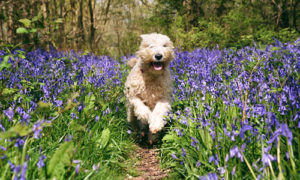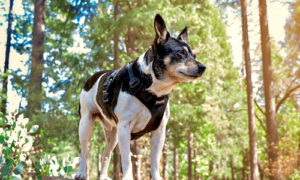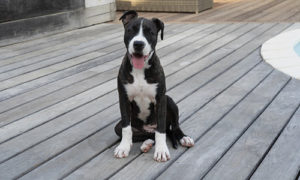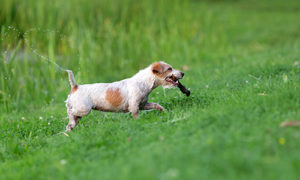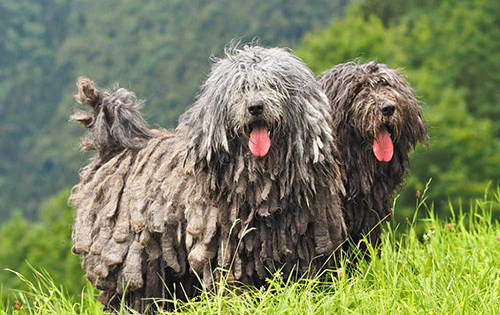
The Bergamasco originated in ancient Persia, where they aided nomadic sheepherders in tending to their flocks as they roamed through rugged mountainous terrains. The dog’s ancestors settled in the Alps, where they bred with the local breeds and further evolved to withstand the harsh climate. Similar sheepdogs, such as the Komodor, Polish Lowland Sheepdog, Pyrenean Sheepdog, Briard, and Puli, all originated from these same ancestor dogs from Persia.
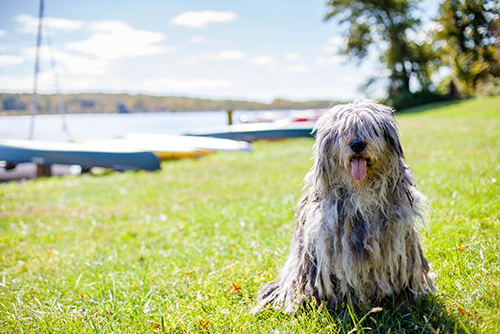
The dogs were most likely flock guardians, but as the flocks needed to be moved, they doubled as flock drovers, which inspired a more obedient yet free-thinking and friendlier temperament. The dogs that settled in the southern Swiss Alps and Italy were known as Cane da Pastore Bergamasco after the seasonal shepherds from Bergamo who came to work in the mountain region.
The Bergamasco were crucial components of goat and sheep farming up to World War II, after which goat and sheep farming declined. The dogs also fell in numbers because of the appeal and novelty of foreign breeds. Dr. Maria Andreoli undertook a concerted effort to revive the breed during the 1960s. Today, the dogs are again utilized in the Italian and Swiss Alps as sheep and goat herders.
The first Bergamascos were imported to America from Italy in the mid-1990s. They were finally accepted into the AKC Miscellaneous Class in 2011, and in 2015 they became a member of the Herding Group.
Breed Standard
Bergamascos are rustic and athletic sheepdogs wholly covered with an abundant, protective coat of flat layers of felted hair. The dogs are solidly and muscularly built; it has small rectangular proportions, a slightly sloping topline, and well-sprung ribs. The thick tail hangs to the hock, tapering and forming a hook in its lower third; it is raised over the back when the dog is in action.
The breed’s head is large, with a slightly domed skull and a blunt, tapered muzzle equal in length. The nose is black and large, the eyes are large, brown, and oval-shaped, and the high-set drop ears are triangular in shape and relatively short. Bergamasco’s overall expression is one of calm and attentiveness.
Breed Facts
| Energy level | Watchdog ability | ||
| Exercise requirements | Protection ability | ||
| Playfulness | Grooming requirements | ||
| Affection level | Cold tolerance | ||
| Friendliness toward dogs | Heat tolerance | ||
| Friendliness toward other pets | Friendliness toward strangers | ||
| Ease of training |
- Popularity: very rare
- Family Group: livestock, herding
- Country of Origin: Italy
- Date Developed: Ancient
- Original Purpose: sheep and goat drovers and guardians
- Current Function: sheep and goat drovers
- Other Names: Bergamasco Sheepdog, Pastore Bergamasco Cane
Group: Herding
Year of recognition by the AKC: 2015
Bergamasco Temperament
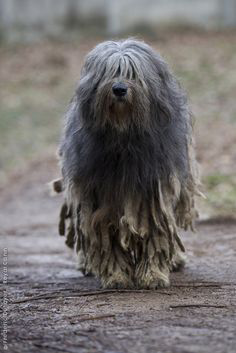
The dog is courageous, self-reliant, protective, and at times independent. The breed’s highly intelligent, pleasant, and easy to please nature makes them enjoyable companions that are pretty responsive to positive training methods. They can be determined problem solvers who enjoy working in unison with their owners.
The Bergamasco Sheepdogs evolved as an independent problem solver, eager to fulfill the shepherds’ tasks without step-by-step guidance. However, the dog is obedient unless it sees a better way to get the job done. They learn new tasks and commands quickly but do not expect them to perform circus tricks. They’re fantastic guard dogs but are friendly once introduced to house guests. They are gentle and fun-loving with their family and are usually good with other pets and dogs. Due to their non-aggressive nature, they are poor protection dogs.
Activity Level
This dog has a strong working drive that requires plenty of daily exercises. The breed does well in rallies, agility, herding, and obedience. They are calmer than other herding breeds. A couple of medium to long walks rather than jogging or sprinting can satisfy the dog’s exercise needs. The breed is an excellent companion when hiking at a slower pace. They prefer more companionship than extreme exercises. Bergamascos love the cold weather. The dogs can also swim, but drying them can take forever, so it is not recommended.
Grooming
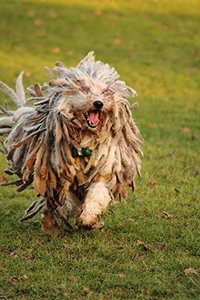
The dense, soft puppy coat should be brushed to prevent mats and tangles. Around one year of age, the coarse goat-like and woolly hair grow in, at which point the hair begins to mat and must be split by hand into flocks. The new mats must be consistently checked and separated as needed to ensure that they do not fuse. The flocked coat does not require brushing and needs bathing only a few times per year.
Coat
A combination of dense, short, fine-textured undercoat, straight, long, rough, “goat hair,” and woolly outer coat. The 3 types of hair combine to form flat “flocks or dreads” of felted fur over the dog’s body that reach full length by around five years of age.
Color: Variations of gray, solid gray, including merle, solid black. Fawn coloring at the ends of the flocks can be seen, and a small number of white markings.
Health
- Main Problems: none
- Minor Issues: none
- Rarely Seen: some orthopedic problems in sterilized dogs
- Recommended Tests: hip
- Life Span: 12 to 15 years
- Weight: male – 70 to 84 pounds; female – 57 to 71 pounds
- Height: male – 23.5 inches; female – 22 inches
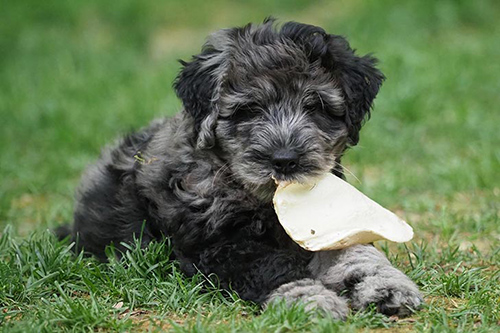
Breeder and Buyer’s Advice
The BSCA requests assurance from member breeders they abide by the terms of the club’s Code of Ethics. Potential owners are strongly encouraged to get documentation of all sales agreements and Bergamasco shepherd classification for the puppies.
Parent Club: Bergamasco Sheepdog Club of America; founded in 1996
Rescue: BSCA rescue can be found on the parent club’s website
Frequently Asked Question and Answers
- How much do Bergamasco puppies’ cost? Expect to pay $1000 to $5000 or more, depending on the breeder and the dog’s pedigree.
- Are Bergamasco dogs’ good family dogs? Yes
- Can you shave a Bergamasco? Yes, but it is not recommended.
- Is a Bergamasco good with kids? Absolutely. These dogs are amazing companions for the entire family.

